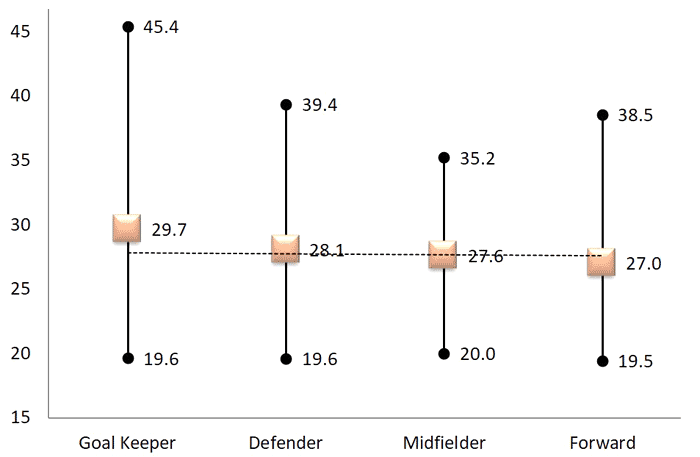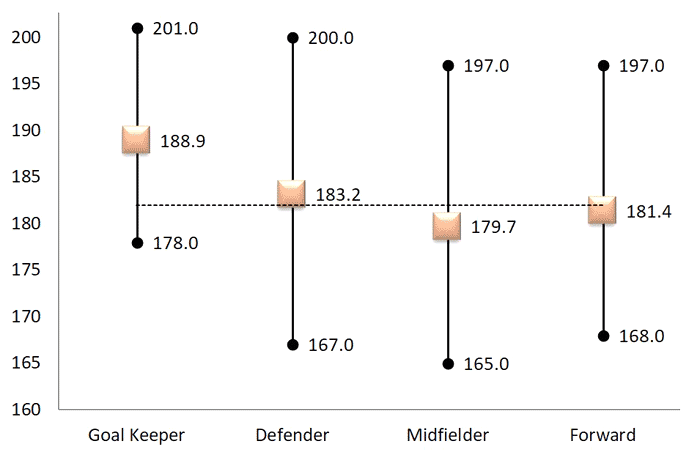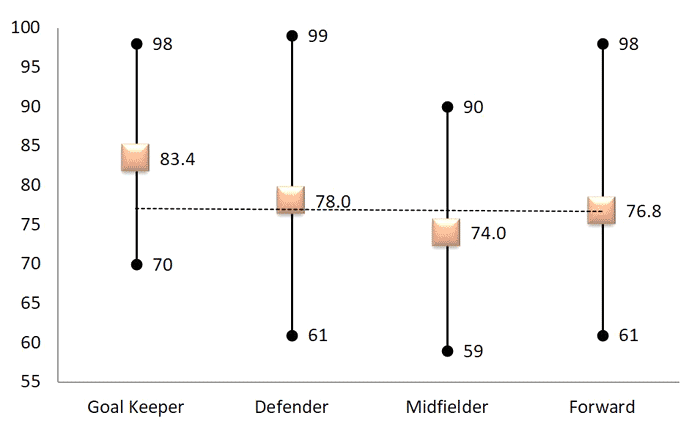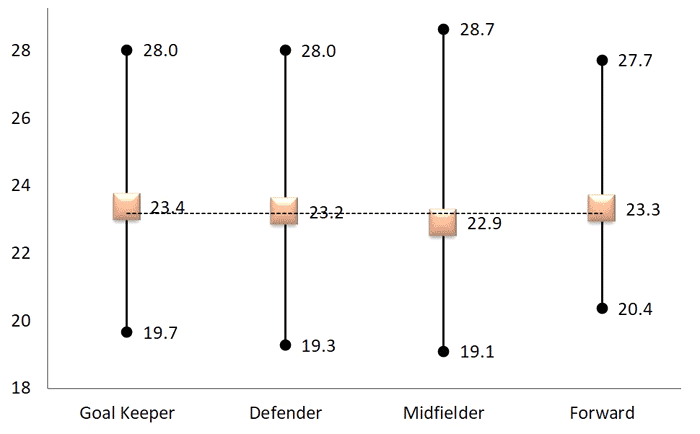Although not the most important attribute for success in football, the body size of players can still play a part in their performance. We have analyzed the 2018 World Cup player data provided by FIFA, which included the height, weight, position played and age of all squads of each nation represented (736 players). The players' BMI was calculated from the height and weight data.
This data has also been compared to similar data from players at the 2002 and 2006 World Cup.
We have been able to compare playing positions and teams to better understand the differences in this data and how it may suit particular players and affect playing performance
There are clear differences in the body size of players depending on the position played on the field. The goalkeepers at the 2018 FIFA World Cup stand out - they tend to be older, taller and heavier than the field players. The youngest are the forwards, the shortest the midfielders, and the leanest based on BMI are the midfielders. Each of these is discussed further below.
Age of FIFA World Cup players in 2018
The youngest player of the tournament was 19-year-old Australian Daniel Arzani, the oldest was Egyptian goalkeeper Essam El Hadary who was 45 years old, the oldest player ever to compete at a world cup. The average age of all players was 27.9 years (shown as the dotted horizontal line on Graph 1 below). 
Graph 1: The age (in years) of all players at the 2018 FIFA World Cup, grouped by playing position. For each group, the average, highest and lowest value are shown. The average age of all players (27.9 years) is indicated by the horizontal dotted line.
The goalkeepers were the oldest on average (29.7 years), a couple of years older than the average forward (27.0 years). Further into the defensive field positions, the players are older, reflecting the greater maturity and experience that comes into play in these critical playing positions.
The youngest teams were Nigeria and France, each with an average player age of 26 years, with England 26.1 not far behind. The oldest teams were Costa Rica (29.6), Mexico 29.4 and Panama (29.3), all from the same region.
Height of all FIFA World Cup players in 2018
The tallest player of the tournament was Croatian goalkeeper Lovre Kalinic,who stands at 201 cm tall (6 ' 7"), at the other end of the scale are a few midfield players measured at only 165cm (5 ' 5") tall. The average height of all players was 182.4 cm (6 ' 0") (the dotted horizontal line on the Graph 2).

Graph 2: The height (in centimeters) of all players at the 2018 FIFA World Cup, grouped by playing position. For each group, the average, highest and lowest value are shown. The average height of all players (182.4 cm) is indicated by the horizontal dotted line.
The goalkeepers literally stand out as the tallest of all playing positions, understandably as the greater reach of tall players is a distinct advantage when defending the goal.
The tallest teams were Serbia (186.6) and Denmark (186.6cm), and the smallest was Peru (177.6cm). There are known height differences in people from different countries, and so it would be interesting to compare the team average height to the average height of residents of that country.
Weight of FIFA World Cup players in 2018
The heaviest player of the tournament was defender Roman Torres from Panama who was 99kg (218 lbs), the lightest being a few midfield players measured at 59kg (130lbs). The average weight of all players was 77.2 kg / 170lbs (dotted horizontal line).

Graph 3: The weight (in kilograms) of all players at the 2018 FIFA World Cup, grouped by playing position. For each group, the average, highest and lowest value are shown. The average weight of all players (77.2kg) is indicated by the horizontal dotted line.
Taller players are expected to weight more, so again goalkeepers on average lead this category. The team with the heaviest players were Denmark (82.6kg), the lightest Japan (71.5kg )
BMI of FIFA World Cup players in 2018
A better understanding of weight can be gained by looking at body weight relative to height, and a common measure of this is Body Mass Index (BMI). While a high BMI is considered a sign of being overweight, athletes tend to have a greater level of muscle mass which can elevate the BMI score and incorrectly label them as overweight. The player with the highest BMI was Swiss midfielder Xherdan Shaqiri with a BMI of 28.7. The lowest BMI calculated was Portuguese midfielder Bruno Fernandes with 19.1. The average BMI of all players was 23.2 (dotted horizontal line).

Graph 4: The BMI of all players at the 2018 FIFA World Cup, grouped by playing position. For each group, the average, highest and lowest value are shown. The average BMI (23.2) of all players is indicated by the horizontal dotted line.
I would not expect many players at the World Cup to be overweight, and therefore the range of BMI scores are an indication of mostly musculature differences. There does not appear to be any trend of differences in BMI between playing positions, and between team there was not a big range. The team with the lowest BMI was Morocco (22.3), the team with the highest was Panama (24.1).
Summary Table of Player Anthropometry Data
| Position | Age | Height (cm) | Weight (kg) | BMI |
|---|---|---|---|---|
| OVERALL AVERAGE (all positions) | 27.9 | 182.4 | 77.2 | 23.2 |
| Goalkeeper | 29.7 | 188.8 | 83.4 | 23.4 |
| Defender | 28.1 | 183.2 | 78.0 | 23.2 |
| Midfielder | 27.6 | 179.7 | 74.0 | 22.9 |
| Forward | 27.0 | 181.4 | 76.8 | 23.3 |
Source: The player data was supplied by FIFA in 2018. The original file is no longer available on their site, but we have a copy here. The height of Abdullah Al-Mayouf was corrected from 178 to 187cm. There may be other errors in the document too.
Related Pages
- Anthropometry of the Players at the World Cup — comparing 2002, 2006 and 2018.
- Height changes of the Brazilian team at the FIFA World Cup
- List of the tallest international football players
- Soccer Anthropometry
- Height and weight of Olympic football players
- Fitness testing for football
- All about fitness testing, including anthropometry testing
- Poll about the fitness components for soccer
- Who Is The Fittest Footballer (Soccer Player) Ever?
- Fitness for Soccer



